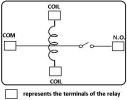This is the diagram below to learn all the pin terminals of a Single Pole Single Throw (SPST) Relay:

The 2 COIL terminals is where the voltage is placed in order to energize the coil. Place the relay's rated coil voltage on these terminals. The polarity of the voltage does not matter. A positive and negative voltage can be placed on either end. Polarity only matters if a diode is used.
The COM terminal is the common terminal. If the COIL terminals are energized with the rated voltage, the COM and the NO terminals have continuity. If the COIL terminals are not energized, then the COM and the NO terminals have no continuity.
The NO terminal is the terminal where you place the output. If there is no voltage to COIL terminals or insufficient voltage, the output is open and receives no voltage. When the COIL terminals receive the rated voltage or a little under, the NO terminal receives sufficient voltage and can turn on the device on the output.

The 2 COIL terminals is where the voltage is placed in order to energize the coil. Place the relay's rated coil voltage on these terminals. The polarity of the voltage does not matter. A positive and negative voltage can be placed on either end. Polarity only matters if a diode is used.
The COM terminal is the common terminal. If the COIL terminals are energized with the rated voltage, the COM and the NO terminals have continuity. If the COIL terminals are not energized, then the COM and the NO terminals have no continuity.
The NO terminal is the terminal where you place the output. If there is no voltage to COIL terminals or insufficient voltage, the output is open and receives no voltage. When the COIL terminals receive the rated voltage or a little under, the NO terminal receives sufficient voltage and can turn on the device on the output.



